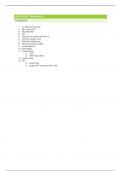Summary
Summary of key infections
- Course
- Institution
- Book
A summary of key infections as covered by Oxford clinical handbook of medicine, passmed and zero to finals. Includes clinical features, key investigations and diagnostic features, management guidelines and other relevant information for each condition. All the management guidelines have been checke...
[Show more]




